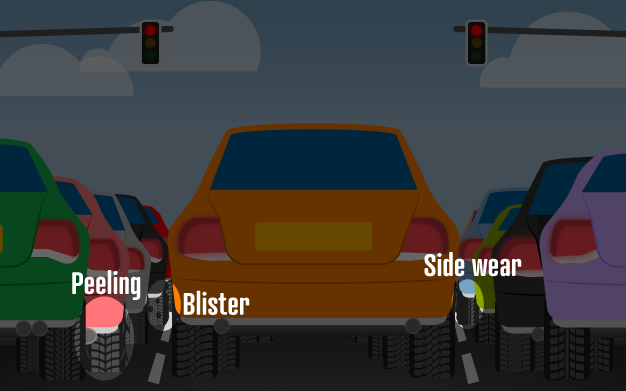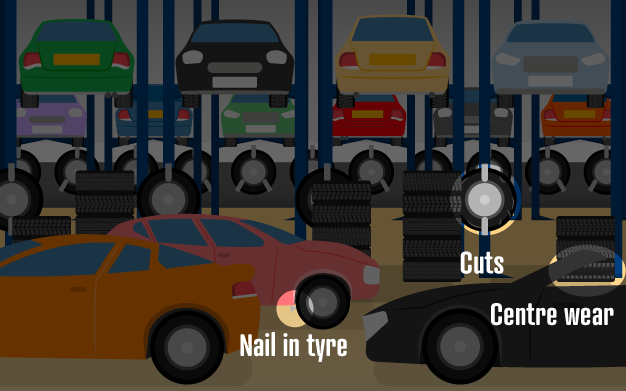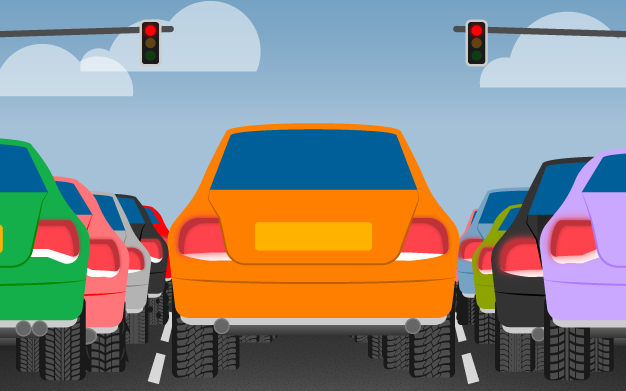Can YOU find the hazardous tyres in the automotive scenes? Extremely tricky brainteasers put the nation’s hazard perception to the test in time for winter!
A fiendishly new seek-and-find puzzle challenges Brits to spot the hazardous tyres in the automotive scenes. This is all in advance of the seasonal ‘winter tyre changeover’ which takes place anytime from October (or when the temperature starts to drop below seven degrees Celsius, as recommended by the AA).
Many people have been stumped by these extremely tricky brainteasers – but how good is your road safety knowledge? And are your tyres prepared in time for winter?
Scroll down to try your luck.
Can you find the hazardous tyres stuck in traffic?
(see main image)
Can you find the hazardous tyres in the garage?


Think you scored full marks on each of our brainteasers? See below, for the answers and a short explanation of each hazard featured in the images.

Typically seen on older tyres, rubber peeling off your tyre’s sidewall can be very dangerous and can potentially cause blowouts – especially when travelling at high speeds. Thankfully, peeling can be easily identified with a close inspection.
Blister
Often caused by impact damage, such as hitting kerbs or potholes in the road, blisters are small lumps (or small ‘bubbles’) in the tyre that must be repaired or replaced immediately. If left unattended, blisters can result in tyre blowouts at high speeds.
Side wear
Side wear is the erosion of tyre treads on the outer rim of the wheel, often the result of consistently under-inflated tyres. With this type of wear, the middle section of your tyre tracks should retain their grip while the sides look and feel smooth. Check your tyre pressure every couple weeks to ensure it is within the manufacturing guidelines for your car model.

Whether it’s a nail or a piece of glass, any sort of foreign object lodged in a tyre needs to be repaired or replaced as soon as possible. These sharp hazards cause flat tyres or even blowouts at high speeds.
Cuts
Cuts in the sidewall let air escape the tyre, deflating it almost imperceptibly over time and causing unexpected flat tyres. Make sure you get your tyre checked out if you find any slits or fissures.
Centre wear
The opposite of side wear, centre wear is when the middle of your tyre treads have been eroded to a smooth surface. Where side wear is typically caused by under-inflated tyres, centre wear is likely due to over-inflated tyres. As with side wear, keep your tyre pressure within your car’s manufacturing guidelines.

Cracks
Holes
While small holes in a tyre do not necessarily cause serious damage, they can lead to a slow puncture and the subsequent deflation of your tyre. So, take the afflicted tyre to be repaired or replaced at the first opportunity.
Cupping wear
Rather than wear occurring around the entire circumference of your tyre, cupping wear is when smooth circles appear on your tyre tread, typically in a straight line. This uncommon type of wear is usually the result of poor suspension or old shock absorbers.

“The winter tyre changeover is a major part of car ownership in the UK, especially once October rolls around. Ensuring your tyres are road-safe keeps you and your car safe from slippery surfaces, especially that dreaded black ice – which is so crucial for morning commuters!

